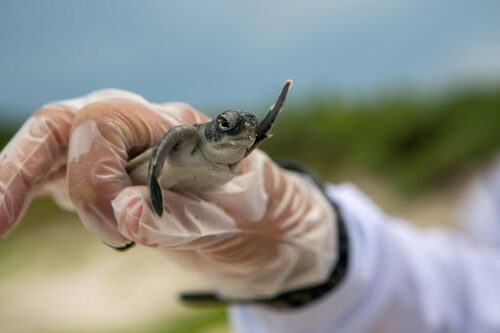Loggerhead sea turtles are one of many migratory animals that rely on magnetoreception, or the ability to sense Earth’s magnetic fields. Sea turtles sense both a magnetic map relative to their particular geographic location and a magnetic compass oriented to the directions of long-range destinations. Recent research led by Kayla Goforth, a postdoctoral research associate at Texas A&M University, seeks to assess the role of these magnetoreception abilities in turtle migration.
Of specific interest to the study was the loggerhead sea turtle, a species that migrates thousands of miles in its journey to nest and feed. Goforth and her team recreated the magnetic signatures of locations across the eastern seaboard of the US in their laboratory by an intriguing approach. The team built magnetic coils that generated electromagnetic fields by running current through electrical wires, simulating the fields at varying global marine environments.
First, Goforth tested turtles’ “map sense,” investigating whether sea turtles could actually remember particular magnetic fields. Every day for two months, young sea turtles were exposed to the magnetic signature of one of two locations. At one of these locations, food was present. At the other location, no food was available. After several months, experimentation showed that turtles would begin to dance, splash, spin, and dip in and out of the water when exposed to the magnetic field associated with a reward. Indeed, the researchers found that turtles are able to associate a magnetic field with a food reward.
Because conditioning was conducted daily, Goforth and her team spent many weekends and holidays in the lab for months at a time. “It was really a team effort to do the conditioning, and I had a phenomenal team of undergraduates that helped me do all of that conditioning, because I did it about five or six years in a row,” Goforth said. For those six years, Goforth and her team tested magnetic “locations” that became successively similar, and each time the turtles were able to learn and recognize the difference. The next step was to dig deeper into the mechanism behind magnetoreception.
The physical mechanism behind turtles’ magnetic sense is still not fully clear. One leading hypothesis, called chemical magnetoreception, posits that energy from light creates chemical excitations in the nervous systems of turtles which are sensitive to the Earth’s magnetic field; the resulting products of the reaction might then provide information about Earth’s magnetic field. If this were the mechanism for magnetoreception, turtles’ magnetic sense would be disrupted by radiofrequency waves.
Testing this idea, Goforth tested turtles that had already been magnetically conditioned and exposed them to radiofrequency waves while in that field. The turtles still danced—the radiofrequency waves did not affect their map sense. In a second experiment, when turtles were required to use their magnetic compass in the presence of interfering radiofrequency, however, they became disoriented and swam in random directions.
Taken in joint, these two outcomes suggest that while chemical magnetoreception could be the mechanism for turtles’ compass sense, there is a different mechanism underlying their ability to recognize unique magnetic signatures—something researchers in the field hadn’t thoroughly considered before Goforth’s research. The exact molecular mechanisms at play in these chelonian compasses may remain unclear, but the work put forward by Goforth and her team serves as a valuable stepping stone in understanding the migratory patterns of sea turtles and the cornucopia of unique migratory species that inhabit our planet.

